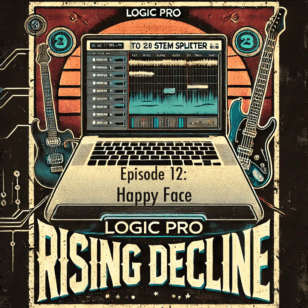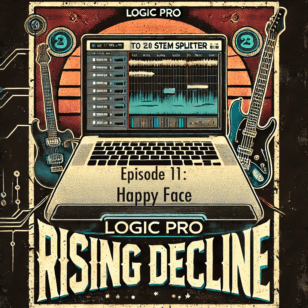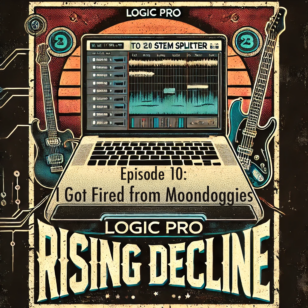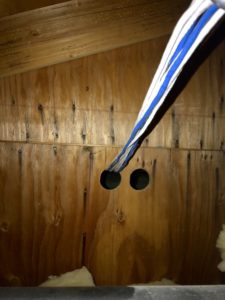 Earlier this week, I was crawling above Ken’s art room relocating eight ethernet cables. In a few weeks, this room will be demolished in preparation for the new Hub. My task was to remove the ethernet cables that used to be in the walls and ceiling and salvage them. There is no easy route to get cables from the switch closet by the kitchen to the art room, so these ethernet cables are precious in the Commons building. After many trips up and down the ladder in the art room, ceramics room, and library classroom upstairs, the eight ethernet cables are safely above the ceramics studio to be used another day.
Earlier this week, I was crawling above Ken’s art room relocating eight ethernet cables. In a few weeks, this room will be demolished in preparation for the new Hub. My task was to remove the ethernet cables that used to be in the walls and ceiling and salvage them. There is no easy route to get cables from the switch closet by the kitchen to the art room, so these ethernet cables are precious in the Commons building. After many trips up and down the ladder in the art room, ceramics room, and library classroom upstairs, the eight ethernet cables are safely above the ceramics studio to be used another day.
So why start a year-end reflection with a recap of cabling? This morning’s dusty venture into crawl spaces encapsulated so much of what my goals of the last two years have been–infrastructure, making, and building the Hub.
And with that, here are five things I focused on this year:
- How might we further prototype projects that involve making?
- Continue to upgrade and fine tune Hillbrook’s infrastructure.
- How might we generate interest in the Hillbrook CTE?
- How might we reach beyond Hillbrook with community partnerships?
- Blog more.
How might we further prototype projects that involve making?
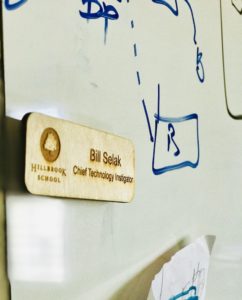 The Hillbrook Way is how we do things in the classroom: we ask, we start, we collaborate, and we show. Every discipline and category of learning at Hillbrook fits into this, and Making is no exception. I sometimes joke that my job title is Chief Technology Instigator, but I feel like that is actually a pretty description of how I try to infuse making and technology into the classroom.
The Hillbrook Way is how we do things in the classroom: we ask, we start, we collaborate, and we show. Every discipline and category of learning at Hillbrook fits into this, and Making is no exception. I sometimes joke that my job title is Chief Technology Instigator, but I feel like that is actually a pretty description of how I try to infuse making and technology into the classroom.
Part of this year’s goal was to create and support interdisciplinary, project-based learning. In some ways, this is an extraordinarily easy goal–so many teachers routinely implement interdisciplinary projects daily. But in other ways, this is a goal that is never attainable. Lessons can always be more interdisciplinary and more hands-on. Our school’s current initiatives–ACE Hour, ICE Time, 8th grade Capstone, and Reach Beyond Week–are all ways in which students can drive their own learning, and that learning is often making-based, tech-focused, and interdisciplinary.
A favorite project from this year was Connor’s iPhone Teardown project. Many third graders set up meetings with me to build a computer or phone or app. One of my favorite parts of these projects is helping students find what is truly interesting to them. In Connor’s case, he was fascinated with how so much computing power could fit into such a small footprint. I encouraged him to take apart a device and document his process. The internet has a name for this: teardowns. I like to think of it as a Breaker’s Space, the inverse of a Maker’s Space. The prerequisite step was to procure an old smartphone, so I reached out to our community and found an iPhone 5 that could be dismantled. Connor slowly but surely took it apart, using special tools and labeling each piece and researching how that component functioned. Surprising to everyone in the class was just how big the battery is (it takes up over half of the real estate inside a phone). This project, like many others, is a powerful example of how student choice can drive authentic learning. It was also a great lesson for me for how I am able to lend my expertise to support students across grades.
This year I had an emphasis on one piece of hardware and one piece of software: the Raspberry Pi and Swift Playgrounds.
Swift is a coding language that iOS apps are built on. Swift Playgrounds is an iPad app used in middle school math classes that teaches students the fundamentals of the language while also teaching computational thinking, an essential skill for coders and mathematicians.
In June 2017, Swift Playgrounds expanded to include physical computing. Now, students can use the app to code robots, drones, and musical instruments. This is a perfect next step for our students as they continue to bring their code to life. Chapter One of our Apple Distinguished School book has many more examples of how we use Swift Playgrounds in the classroom.
The Raspberry Pi is a tiny and affordable computer that you can use to learn programming through fun, practical projects. Shea, Chris, and I took an R&D Day last August to explore the Pi further. We created an Alexa Pi by installed the Alexa Voice Service (AVS) onto a Raspberry Pi, and configured the hardware to respond to the word Alexa. Emily also recently attended the PiCademy, a two-day conference hosted by Raspberry Pi offering educators a deep dive into physical computing.
Our new schedule includes integrated blocks which will further the possibility for interdisciplinary project-based learning.
Continue to upgrade and fine tune Hillbrook’s infrastructure.
This year, I worked with Aaron Yoffe at Novani to provide a more consistent internet browsing experience, with the primary focus on wifi access point tuning. Our wireless network Meraki provides great functionality out of the box, but leads to a more difficult experience when it’s time to fine tune a network. Similar to radio stations, wifi access points broadcast on specific channels. We manually set channels for both the 2.4GHz and 5GHz (similar to AM and FM) bands, which has led to less interference between access points, particularly in the middle school where devices and access points are more densely populated. We continue to adjust the power so that devices are forced to connect to the closest access point (AP), and so that they will disconnect when there is a closer access point. I’ve learned that this step is as much art as science, and definitely have a better understanding with the relationship between AP density, AP power, and device density.
I am continuing to troubleshoot the new VoIP phone systems. Novani installed network monitoring software to track packet errors in hopes of diagnosing phone connectivity issues. In early June, Aaron determined that there is bottleneck in H2. All switches on the middle school side of campus pass through this switch; upgrading this switch should solve many perceived connectivity problems with both devices and phones.
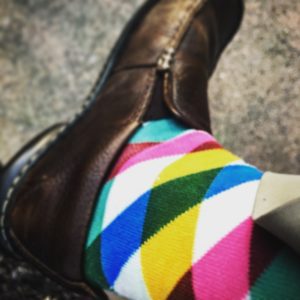
This year we revisited the tech ticketing system. Using the Hillbrook Way, we started by slowly implementing Slack. The initial plan was to create a tech help channel and empower faculty and staff to troubleshoot independently by searching the channel before submitting a ticket. Ultimately, private messages in Slack were used most regularly. As a tech team, we continue to receive emails, text messages, and formal tickets to MyTechDesk asking for assistance. Ultimately, we’ve been willing to respond to all platforms, mostly due to the fact that we are remotely managing both laptops and computers, thus saving large amounts of time. We will continue to look at a more sustainable way to manage tech tickets in the future.
Aaron from Novani and I audited the servers, including the Active Directory server, to ensure they are optimized and meet our current and future needs. Novani is recommending plans to upgrade our core switch in the near future. All network traffic passes through this one hardware appliance, so keeping it up-to-date will be one step in ensuring a more consistent network experience.
How might we generate interest in the Hillbrook CTE?
This year’s plan was to use the CTE podcast as a catalyst for future CTE events, where I would work with Annie Makela to create and publish a monthly CTE podcast to share our social entrepreneurship story and share the work of the CTE with professional learning. We recorded many interviews and conversations, and published five podcast episodes this year. I recently added analytics to our podcast feed, and discovered that we’ve had 60 downloads in the last four weeks. With the addition of two large diaphragm condenser mics, enthusiasm around being on the podcast has notably increased. With a total of ten episodes, this platform feels like it’s finally gaining momentum, but internally and externally.
Since this is a blog post, here’s a shoutout to people, accounts, and website you totally should be following:
How might we reach beyond Hillbrook with community partnerships?
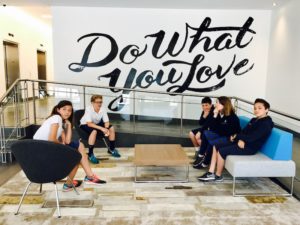 My reason for this goal was to ensure our school continued to connect with other community institutions to further the work of the CTE. This goal also included me working with Ilsa and Annie to develop a satellite space at WeWork Valley Towers. Basically, Annie rocks. She has made many connections this past year. Ten months ago, we had three Hot Desk accounts with WeWork and occasionally visited the downtown San Jose facility to work. We also had a couple events hosted at NuMu in downtown Los Gatos. Since Annie’s arrival as the Founding Director of the Scott Center for Social Entrepreneurship, our school has become thoughtfully connected with several local organizations.
My reason for this goal was to ensure our school continued to connect with other community institutions to further the work of the CTE. This goal also included me working with Ilsa and Annie to develop a satellite space at WeWork Valley Towers. Basically, Annie rocks. She has made many connections this past year. Ten months ago, we had three Hot Desk accounts with WeWork and occasionally visited the downtown San Jose facility to work. We also had a couple events hosted at NuMu in downtown Los Gatos. Since Annie’s arrival as the Founding Director of the Scott Center for Social Entrepreneurship, our school has become thoughtfully connected with several local organizations.
Over the last school year, we continue to partner with NuMu for Hillbrook events. We now have a dedicated office, affectionately referred to as our satellite space, in WeWork Valley Towers. Three significant outcomes resulted from our time at WeWork. First, we hosted an Educators & Social Impact Leaders Networking Happy Hour. Led by Kate Ferguson, Director of the Resident Teacher Program, and Annie Makela, this event brought together forward-thinking educators and community members. Second, we used the conference rooms for big and small events as a way to host groups off-campus. Notably, groups during Reach Beyond Week utilized WeWork conference rooms during their time in San Jose. Finally, Annie partnered with Kiva, a micro-lending nonprofit. This will most definitely not be a goal next year. Annie’s got it handled and continues to do amazing things.
👨🏻💻Blog More as an Educator.
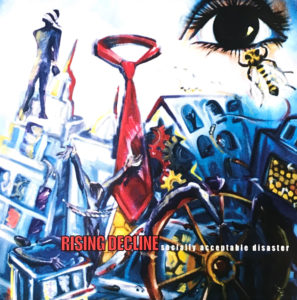 Inspired by Colleen and her blog Keep It Simple, Schilly, I added this goal to share my own professional journey through my blog and podcast. Pretty quickly, I pivoted to more podcasts and less blog posts. This school year, I published ten blog posts and 15 podcast episodes.
Inspired by Colleen and her blog Keep It Simple, Schilly, I added this goal to share my own professional journey through my blog and podcast. Pretty quickly, I pivoted to more podcasts and less blog posts. This school year, I published ten blog posts and 15 podcast episodes.
This was in addition to the work on the Hillbrook CTE blog and podcast. Our school continues to do incredible work in the realm of educational technology. Creating content to share is always challenging time-wise, but there is never a lack of stories to be told about ways our students, our faculty, and our staff continue to reach beyond themselves to make a difference in the world.
